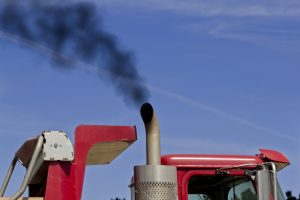Congress should act now to accelerate the transition to zero-emission trucks
 Every mode of freight transportation – from planes and trains, to trucks and ships — has a significant pollution footprint that dirties the air in communities near freight facilities and highways, while contributing to the climate crisis.
Every mode of freight transportation – from planes and trains, to trucks and ships — has a significant pollution footprint that dirties the air in communities near freight facilities and highways, while contributing to the climate crisis.
Yet, reducing pollution from the freight movement is not primarily a technology matter. It is a matter of political will.
Today, I hope to convey this message before two House Transportation & Infrastructure subcommittees at an important hearing on the economic, environmental and societal impacts of freight transportation. I also hope that my testimony — and that of others at the hearing — will help the House develop a 2020 transportation bill that builds on the Senate’s version of the Highway Reauthorization Bill approved earlier this year.
With Congressional leadership, we can make tremendous strides in reducing the nearly 11,000 premature deaths annually occurring from exposure to freight pollution in this country and put the sector on a path to contribute to a 100% clean economy by 2050.
Federal policy is key to transforming freight
As the leading source of both local and global air pollutants from freight, heavy-duty trucks require specific focus from Congress.
Zero-emission alternatives are increasingly viable, as evidenced by the surge of product announcements over the past two years for parcel delivery trucks, urban delivery trucks, yard trucks, and regional trucking. Over two dozen truck models are in production or development. All major original equipment manufacturers and several new entrants have zero-emission offerings.
Congress should act now to accelerate the transition to zero-emission trucks Share on XYet despite this progress, diesel trucks will still account for more than half of the trucks on the road in 2050 at our current pace of adoption.
Federal policy leadership will be critical to accelerate this transformation to zero-emission vehicles, which would drive down carbon emissions; reduce air pollution, especially in urban communities; and strengthen a cornerstone manufacturing base that provides well-paying jobs.
Well-designed policy can advance four objectives that will collectively determine the impact and pace of adoption for zero-emission vehicles:
1. Encourage the production of zero-emission heavy-duty vehicles
Example polices include:
• Launching a program that provides direct government loans for heavy-duty vehicle manufacturers to produce zero-emission trucks. A program of this sort would enable manufacturers to expedite bringing zero-emission heavy-duty trucks to market.
• Increasing funding to the Department of Energy’s Office of Energy Efficiency and Renewable Energy, which could be targeted at technology advancements, such as enhancing charging systems and advancing battery design to enable lighter, more energy-dense and lower-cost batteries.
2. Increase the demand for zero-emission heavy-duty vehicles
Example policies include:
• Suspending the federal excise tax on zero-emission trucks. This tax is based on the purchase price of the vehicle and therefore exacerbates the upfront cost discrepancy between diesel and zero-emission trucks. Policymakers should waive this tax for zero-emission trucks through the mid-2020s, when the upfront costs of diesel and zero-emission trucks are expected to start converging.
• Expanding the Diesel Emissions Reduction Act (DERA). DERA, which was first enacted in 2010, funded a highly popular and bipartisan set of projects that protect human health and improve air quality by curbing diesel emissions. It is currently funded at $75 million a year. A significant increase in this program to support the replacement of old diesel vehicles with ZEVs could help increase fleet turnover and get more ZEVs on the road as quickly as possible.
3. Ensure public expenditures drive just and equitable outcomes
Example policies include:
• Giving preference to deployments of ZEVs in low-income communities and communities of color, which are disproportionately impacted by diesel truck pollution.
• Creating a commission to develop strategies to transition drayage trucks — which transport goods over short distances and are a significant contributor to poor air quality in numerous major metro areas — to zero-emission vehicles. Given the urgent need to drive down pollution around ports and rail yards where many frontline communities are located, a federal commission should be established to develop recommendations for fully transitioning these vehicles to zero emissions by 2030.
4. Support the development of appropriate charging infrastructure
Example policies include:
• Directing the Department of Transportation and the Department of Energy to work with states to define a comprehensive national EV charging infrastructure plan. Doing so will help alleviate range anxiety, mitigate expensive, unnecessary grid upgrades, and facilitate greater integration of renewable energy.
While freight is a major source of air pollution, solutions are at hand, and Congress should act now to accelerate the transition to these vehicles. With bold action, zero-emission vehicles can account for at least 30% of new heavy-duty vehicles sales nationally by 2030 — putting the industry on a path to contribute to a 100% clean economy by 2050. Doing so will help bolster our manufacturing base, create jobs and position the U.S. to export solutions globally, while equitably reducing health impacts to communities and showing global leadership in fighting climate change.










